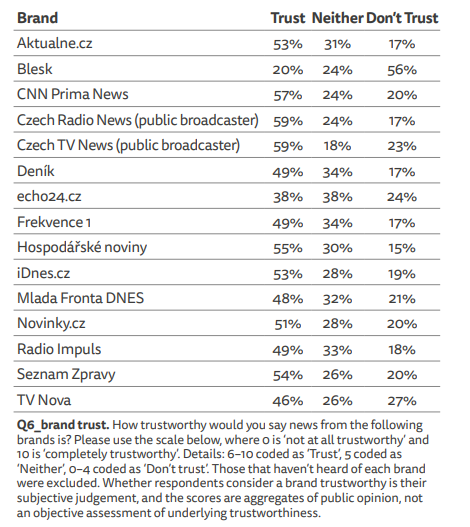Overall trust in news media in the Czech Republic rose last year from a historic low in 2023 to reach 33%. This is two percentage points more than a year ago. On the other hand, several of the strongest brands have seen a decline in trust. Nevertheless, public service media remain among the most trusted sources of news for the Czech audience, according to this year's report Digital News Report 2025 by the Reuters Institute.
According to the report, news consumption continues to decline in the Czech Republic. The use of all types of media as news sources, including online platforms and social networks, was the lowest in the last year since 2016. People most often get their news from the internet (80%) and then from television (60%). Social networks are used by 44% of users and print by 14%. These results are similar to those from a year ago.
New to the survey are news podcasts, which are used by 8% of users in the Czech Republic, and AI chatbots (6% of users).
Smartphones have overtaken desktops as the main device for consuming TV news for the first time.
Respondents rated news from Český rozhlas (trusted by 59%) and Česká televize (trusted by 59%) as equally trustworthy. This was followed by CNN Prima News (57%), Hospodářské noviny (55%) and Seznam Zprávy (54%). However, not all news media are included in the survey, so this is not a complete list of media outlets ranked by trustworthiness. Of the five mentioned, only CNN Prima News improved year-on-year (+1 pb.), while Czech Television remained at the same score as last year. The other media mentioned fell by several percentage points.
According to the survey, the proportion of people who pay for news in the Czech Republic has not changed over the year, reaching 13%. This is the same proportion as a year ago.
 Share of media types in news consumption; Source: Digital News Report 2025, Reuters Institute
Share of media types in news consumption; Source: Digital News Report 2025, Reuters Institute Percentage (%) of responses: I trust, neither trust nor distrust, and distrust the news coverage of selected media outlets. Not all media outlets are surveyed; this is not a comprehensive ranking; Source: Digital News Report 2025, Reuters Institute
Percentage (%) of responses: I trust, neither trust nor distrust, and distrust the news coverage of selected media outlets. Not all media outlets are surveyed; this is not a comprehensive ranking; Source: Digital News Report 2025, Reuters InstituteTrustworthy brands are in demand
According to this year's study, traditional news media in most countries around the world are struggling to connect with a large part of the public: engagement, trust and digital subscriptions are all declining. The accelerating shift to news consumption via social media and video platforms further weakens the influence of ‘institutional journalism’ and strengthens a fragmented alternative media landscape in the form of podcasters, YouTubers and TikTok creators. These trends are most pronounced in the United States, but also in parts of Asia, Latin America and Eastern Europe.
In other areas, particularly where news brands maintain strong relationships with their audiences, they are slower to take hold. It also appears that in an era of ‘synthetic content and disinformation,’ people of all generations still value trusted brands with a long-standing reputation for accuracy, even if they use them less than before.
Global key findings
- Traditional media (TV, print, news websites) continue to lose audience share, while dependence on social networks, video platforms and aggregators grows.
- Influential influencers and podcasters (e.g. Joe Rogan in the US or Hugo Travers in France) reach a significant portion of the younger generation. In Asia (e.g. Thailand), young news content creators play a crucial role.
- The use of online platforms for news consumption is becoming increasingly fragmented. While ten years ago, only two networks reached more than 10% of users per week, today there are six such platforms. Approximately one-third of respondents in the global sample follow the news every week on Facebook (36%) and YouTube (30%). Instagram and WhatsApp are used for this purpose by approximately one-fifth of users (19% each).
- TikTok is the fastest growing network, but also one of the main sources of disinformation (especially in Thailand and Malaysia).
- 7% of people use AI platforms or chatbots to follow the news, with 15% of those under 25 doing so.
- AI can help personalise content, but people are concerned about lower transparency and accuracy. The greatest interest is in features such as summarisation, translation and article recommendations.
- Podcasts appeal mainly to younger and more educated audiences, with most now also available in video format (e.g. on YouTube or TikTok).
- Willingness to pay for online news is stagnating, with only 18% of people in wealthier countries paying for a subscription. The highest number of paying subscribers is in Norway (42%), while the lowest is in countries such as Greece, Serbia and Croatia (6–7%). There is growing interest in flexible payment models (e.g. news packages).
- 58% of people are concerned that they cannot distinguish between true and false news.
- Online influencers and internet personalities (47%) and politicians (47%) are considered the main sources of false or misleading information worldwide.
- Trust in the media remains stable at 40% for the third year in a row, although it is lower than during the pandemic.
- Despite the fragmentation of the information environment, trusted brands continue to hold sway.
You can read the full report here.
Source: mediaguru.cz

